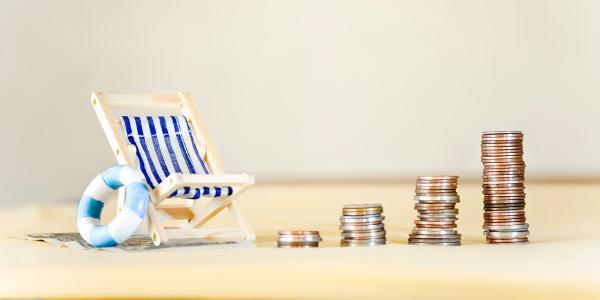Holiday pay: information for employers
Most workers are legally entitled to paid holidays/annual leave. On this page, we look at the rules in more detail and explain how to calculate and pay holiday pay. It should be noted that holiday pay is a complex and ever-changing area of law.

Content on this page:
Basic information
A worker's statutory paid holiday entitlement is 5.6 weeks – this equates to 28 days for a worker working a five-day week. The 5.6 weeks is a minimum entitlement – you can choose to offer more. You must set out an employee's paid holiday entitlement in their contract (or written statement of terms and conditions of employment).
A worker's entitlement to paid annual leave starts on the first day of employment and is not subject to a minimum period of employment.
Employers are allowed to operate a holiday accrual system for workers who are in their first year of employment. In practice this means that a new worker will accrue one twelfth of their annual holiday entitlement each month they are employed. This will apply from the start of each month. So, if you take on a new full-time employee on 1 June 2024, after three month's work, they will have accrued 7 days leave (28 x 3/12).
If the worker’s employment ends (for example, because they have resigned or you have made them redundant), the worker is entitled to be paid for any leave entitlement that they have not taken. Entitlement for those who leave part way through a year is pro-rated to calendar days employed in the leave year, less entitlement already used.
The genuinely self-employed do not have the right to any minimum paid holiday entitlement – they can take as little or as much holiday as they choose. However, like the minimum wage and auto-enrolment, those that are considered ‘workers’ for employment law purposes do – see our page on employment law status for more information on workers.
Part time workers
Paid holiday entitlement for part-time workers is calculated on a pro-rata basis. If, for example, your employee works three days a week, they are entitled to 16.8 days (28 days x 3/5).
| Days employee works a week | Holiday entitlement (days) |
|
1 |
5.6 |
|
2 |
11.2 |
|
3 |
16.8 |
|
4 |
22.4 |
|
5 |
28 |
Where calculations result in part days, e.g. 16.8 days, it may be easier to round the entitlement up to the nearest full day or half day, if this is easier for you to administer (you cannot round it down). Alternatively, you could work the holiday out in hours, so in the case above, 0.8 of a day for someone working an eight-hour day, is 6 hours and 40 minutes – your employee could, for instance, come in to work for part of a day and then take the rest of the day off.
Irregular hours and part year workers
If you have hired someone on a casual basis or very irregular hours (for example, they are on a zero-hours contract), the strict position for calculating holiday entitlement can be found on GOV.UK (this guidance was published in November 2019 to take into account the emerging principles from the case of Harpur V Brazel as it progressed through the courts - more on this case below).
However, notwithstanding this, our understanding is that some employers have often used a ‘short-cut’ to calculate holiday entitlement on the basis of 12.07% of hours worked. The holiday entitlement of 5.6 weeks is equivalent to 12.07 per cent of hours worked over a year (the 12.07% figure is 5.6 weeks' holiday, divided by 46.4 weeks (being 52 weeks – 5.6 weeks)). This method aims to ensure that casual or irregular workers build up holiday entitlement in the same proportion to hours worked as a standard worker.
Harpur v Brazel
The Harpur V Brazel case referred to above eventually went to the Supreme Court and in 2022 it ruled that it was not correct to use the 12.07% method for a zero hour contract music teacher whose holiday pay at the end of each school term was calculated as 12.07% of her earnings in the previous term. The 12.07% method meant her holiday entitlement was prorated both for her irregular hours, but also on the basis that she only worked part of the year (term time). The Court said that this was incorrect and the teacher was entitled to 5.6 weeks leave at her average earnings, because she was employed for the entire year, even though she only worked for part of the year.
This case means some workers may be entitled to more holiday than before.
However, this judgement is in the context of a ‘part-year’ worker only. Most workers are probably not part-year workers as they will not have significant numbers of weeks in a year where they are not working or not on leave – they are likely to be full-year workers who just have irregular hours, rather than part-year workers.
Our understanding is that the 12.07% method will continue to produce the more or less the correct result for irregular hours/zero hour workers, who work a full year.
Leave periods beginning on or after 1 April 2024
New rules came into effect for leave periods beginning on or after 1 April 2024, which are clearly set out on GOV.UK and the main features are as follows:
- introducing a method to calculate statutory holiday entitlement for irregular hours and part-year workers – as defined (see section 3.1 of the GOV.UK guidance)
- introducing a method to work out how much leave an irregular hour or part-year worker has accrued when they take maternity or family related leave or are off sick (see section 3.4)
- introducing rolled-up holiday pay as an alternative method to calculate holiday pay for irregular hours workers and part-year workers (see section 5.2)
With a few important tweaks (such as around accruing leave when a worker is sick), these rules essentially put the 12.07% of hours worked calculation for holiday entitlement on a statutory footing. Note that until your workers are impacted by the proposals – and this will depend on when their holiday year starts - holiday entitlement should be calculated in line with the existing position.
For more information on the calculation of holiday pay for irregular and part year workers, see the section on ‘Working out holiday pay’ below.
Dealing with bank holidays
Contrary to popular belief, you do not legally have to give your employee paid time off for bank/public holidays (unless their contract provides for this). However, you or your employee may choose to include bank/public holidays as part of their holiday entitlement, which will then reduce their remaining annual leave entitlement accordingly.
If you have a full-time employee, with 28 days holiday entitlement, who takes all the bank and public holidays off (typically 8 a year), this leaves them with 20 days' annual leave.
A common myth is that there is a right to extra pay for working on bank holidays – for example, time-and-a-half or double pay. This is incorrect – this would only be the case if their contract provides for this.
In recent times, there have been extra bank holidays – for the late Queen’s Jubilee and King's Coronation for example. If you want to give your staff the extra bank holiday this is straightforward (for example by doing a simple variation to the employment contract). If you do not want to accommodate this, to work out whether you must give your worker the additional day in situations like this, you have to look at what their contract says:
| What the contract states | Treatment of additional bank holiday |
| 28 days – silent on bank holidays | The additional day would have to come out of the 28 days |
| 20 days plus bank holidays | An additional day would be due |
| 20 days plus 8 bank holidays | Potentially due as part of the 8 days (however you would need to determine which other bank holiday would not be due – this would need to come out of the 20 days) |
| 20 days plus 8 bank holidays - specifically naming the days | The additional day would not be due – would need to come out of the 20 days |
Booking leave and other practicalities
Your employee must give you notice that they wish to take leave. You should agree the notice period with your employee and set this out in writing. If there is no agreement in place, they must give notice of at least twice the length of the intended leave period.
Please note that although you can refuse to grant leave at certain times, for example if it is not a convenient time for you, you cannot refuse to let your employee take the leave at all.
Employers can set times that workers are required to take leave. For example, you could tell your employee that they must take two weeks annual leave in the summer when you normally take your own holiday.
If you do not have an agreement for taking leave and you want your employee to take all or part of their holiday entitlement on certain dates, you must give notice of at least twice as long as the leave period.
The GOV.UK guidance setting out the reforms to holiday entitlement and pay which come into effect for leave periods beginning on or after 1 April 2024, also covers issues you may need to know about like carrying over leave, including (among other things) where your worker has an inability to take holiday as a result of sickness and family leave.
Holiday if employee is off sick or on parental leave
Employees taking statutory parental leave like maternity, adoption, paternity and parental leave will continue to accrue paid holiday. They will also build up holiday entitlement while off work sick. However, if your employee is on statutory sick pay (SSP) and it is too little for them to live on, one possibility is that they may ask to take annual leave rather than SSP. More information can be found on the ACAS website.
Working out holiday pay
If your worker has fixed hours and pay (for example, you are a full or part time employee), they should typically be paid the same rate while they are on holiday as they are normally paid in their job. For example, if they usually get paid £500 for a weeks' work, they will still be paid £500 when they take a week off. If they only take a day off (and normally work five days a week), you would probably pay them around £100. The idea is that they shouldn’t be at financial detriment when on annual leave.
If your worker is an irregular hours or part year worker, the amount they should get will typically be based on the average amount they earned. Since 2020/21, holiday pay in England, Wales and Scotland is calculated based on their average pay rate in the preceding 52 weeks that they have worked, including regular bonuses, overtime, commission where relevant. If they have not been in employment for long enough to build up 52 weeks’ worth of pay data, you should use however many complete weeks of data you have. In Northern Ireland, it is based on average pay in previous 12 weeks.
There is clear guidance on how to calculate holiday pay on GOV.UK.
The payment for holiday pay will be due at the same time as your worker’s normal wages (for example, weekly/monthly) and will be treated as earnings for Pay As You Earn (PAYE) tax and National Insurance purposes.
Except for some irregular hours or part-year workers (see below) note that strictly, your worker should receive their holiday pay at the time that leave is actually taken.
It has been unlawful for employers to not pay someone while they are on holiday and pay them an extra amount as part of their wages or salary instead – a system known as rolled-up holiday pay, even though many workers would prefer that. However, for irregular hours or part year workers (as defined) and holiday years starting from 1 April 2024, rolled up holiday pay is now an option – see the section Leave periods beginning on or after 1 April 2024 above. This allows employers to include 12.07% of a worker’s pay in a pay period as an additional amount to cover the worker’s holiday pay. Again, this will be treated as earnings for pay as you earn (PAYE) tax and National Insurance contributions (NIC) purposes. They then do not receive any holiday pay at the time they take the leave.
If employers are not using rolled up holiday pay, they must use the ‘average pay rate’ calculations.
Rolled up holiday pay should not be used to top up worker’s pay to meet the National Minimum Wage. You can find more information about rolled up holiday pay on GOV.UK.
More information
You can find basic information on holiday leave and payon GOV.UK. There is also a tool on GOV.UK to help employers calculate their workers’ holiday entitlement.
For leave periods beginning before 1 April 2024, information about holiday entitlement and how it should be calculated for workers with irregular working patterns is available on GOV.UK. Guidance on how to calculate holiday pay for workers whose hours and/or pay are not fixed can be found here on GOV.UK.
A full summary of the recent significant reforms in this area, which attempt to simplify and clarify certain things, particularly for workers with irregular working patterns can be found on GOV.UK. It includes several worked examples.
If you are unsure as to whether you are dealing with holiday correctly, you could seek further clarification from ACAS.
Please be aware that disagreements and disputes over holidays and holiday pay are very common and can lead to problems such as a deterioration in your relationship with your employee or an increase in their sick leave. As such, you should make sure you try and understand the rules around their entitlements as far as possible and also set out your expectations around things like giving sufficient notice of leave clearly (ideally in writing), so you can avoid any problems later on.
If problems do arise, you could try and sort things out informally with your employee. If this doesn’t work, your employee could take you to an Employment Tribunal, although there are strict time limits for this.



